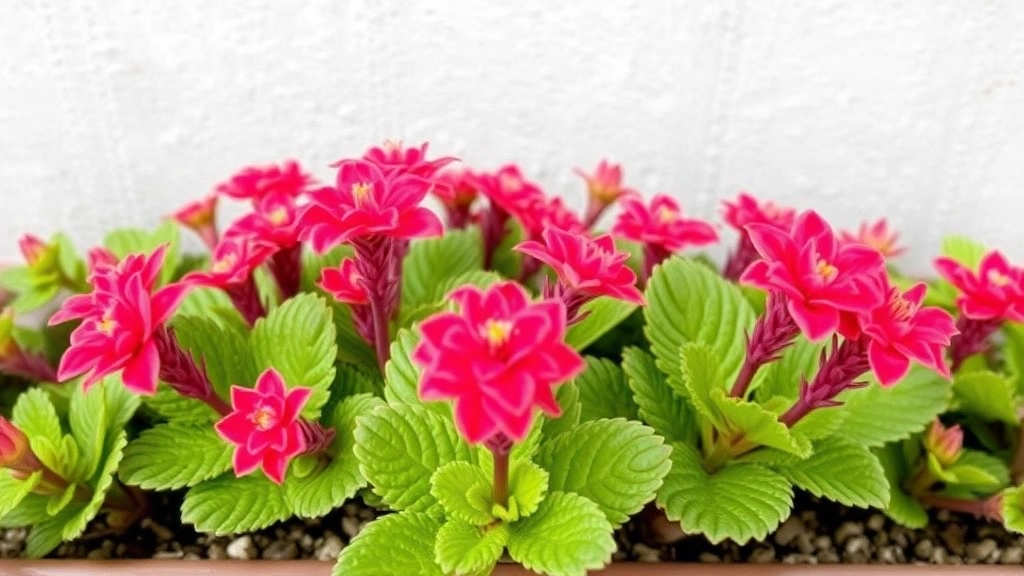Understanding Kalanchoe Temperature
Understanding the ideal Kalanchoe temperature range is crucial for keeping these vibrant plants healthy and thriving. As a plant enthusiast, I’ve learned that Kalanchoes prefer a temperature range between 60-85°F (15-29°C). This ensures they flourish without the risk of damage from extreme cold or heat.
Temperature Risks
When temperatures drop below 50°F (10°C), Kalanchoes can suffer, leading to wilting or even death. On the flip side, consistently high temperatures above 85°F (29°C) can stress the plant, causing its vibrant leaves to lose their colour.
Maintaining the Right Temperature
By maintaining the right Kalanchoe temperature range, you can enjoy these beautiful plants all year round.
Ideal Temperature Range for Kalanchoe
When caring for Kalanchoe, one of the most common concerns is ensuring the plant thrives in the right temperature range.
So, what is the ideal temperature for Kalanchoe?
Kalanchoe, a popular succulent, flourishes best in temperatures between 20°C to 25°C (68°F to 77°F).
This range mimics its native tropical environment, allowing the plant to grow robustly and produce vibrant blooms.
Key Points:
- Daytime Temperature: Aim for 20°C to 25°C.
- Nighttime Temperature: A drop to around 15°C is acceptable.
- Avoid Extremes: Temperatures below 10°C (50°F) or above 30°C (86°F) can cause stress.
For more detailed care information, you might find our Kalanchoe plant lifespan care tips useful. Additionally, if you are interested in the blooming patterns, check out our guide on Kalanchoe flowering season care.
Temperature Tolerance of Kalanchoe
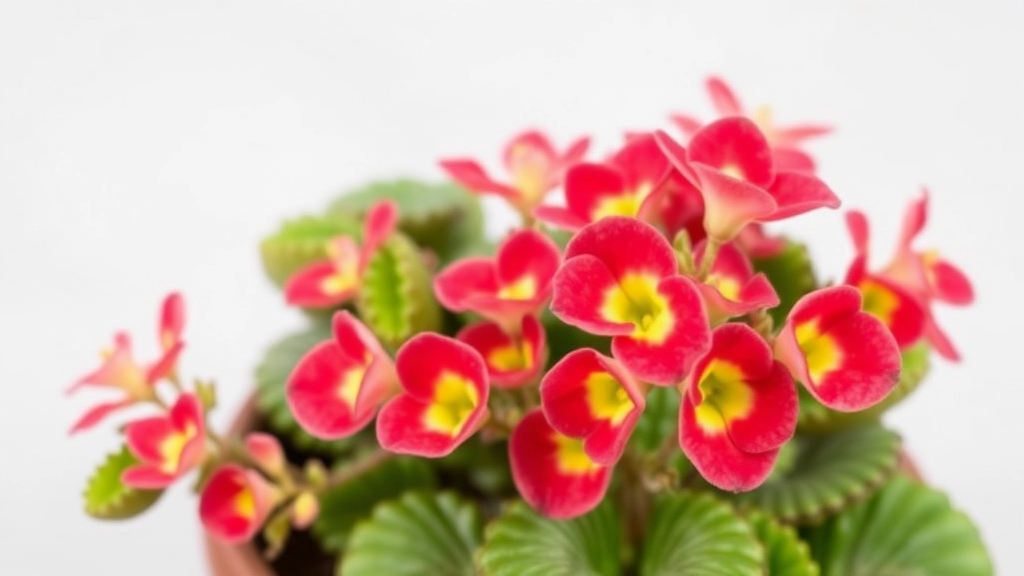
Are you worried about whether your Kalanchoe can handle the temperature shifts in your home or garden?
Kalanchoe plants are pretty resilient when it comes to temperature.
They generally thrive in a range between 15°C to 25°C (59°F to 77°F).
But here’s the kicker: they can tolerate a bit outside this range too.
Temperature Tolerance Breakdown:
- Ideal Range: 15°C to 25°C (59°F to 77°F)
- Minimum Tolerance: Down to about 5°C (41°F)
- Maximum Tolerance: Up to around 30°C (86°F)
While they can handle these extremes, it’s best not to push them too far.
If you live in a particularly hot or cold area, you might need to keep an eye on your Kalanchoe.
They don’t like sudden temperature changes, so gradual shifts are key.
For instance, if you’re moving them indoors during colder months, do it slowly to help them adjust.
Understanding their temperature tolerance helps you create a perfect environment for your plant.
Effects of High Temperatures on Kalanchoe
When considering the ideal environment for Kalanchoe, it’s crucial to address the impact of high temperatures.
High Temperatures and Plant Health
Kalanchoe thrives in warm conditions, but excessive heat can lead to several issues:
- Wilting Leaves: One of the first signs of stress is wilting. Leaves may droop and lose their firmness.
- Leaf Scorch: Prolonged exposure to high temperatures can cause leaf tips to turn brown and crispy, a condition known as leaf scorch.
- Reduced Growth: While Kalanchoe is generally a fast-growing plant, extreme heat can slow down its growth, leading to stunted development.
- Flower Drop: High temperatures can cause flowers to drop prematurely, reducing the overall beauty of the plant.
- Pest Attraction: Heat can make Kalanchoe more susceptible to pests like aphids and spider mites, which thrive in warm conditions.
Mitigating High Temperature Effects
To protect your Kalanchoe from high temperatures, consider the following tips:
- Provide Shade: During the hottest part of the day, move your plant to a shaded area or use sheer curtains if indoors.
- Water Wisely: Ensure your Kalanchoe is adequately watered, but avoid overwatering, as this can lead to root rot. For more detailed instructions, check out our guide on how to water a Kalanchoe.
- Humidity Control: If possible, maintain a humid environment. This can help alleviate some stress caused by high temperatures. For additional care tips, visit our complete guide to Kalanchoe plant care.
Effects of Low Temperatures on Kalanchoe
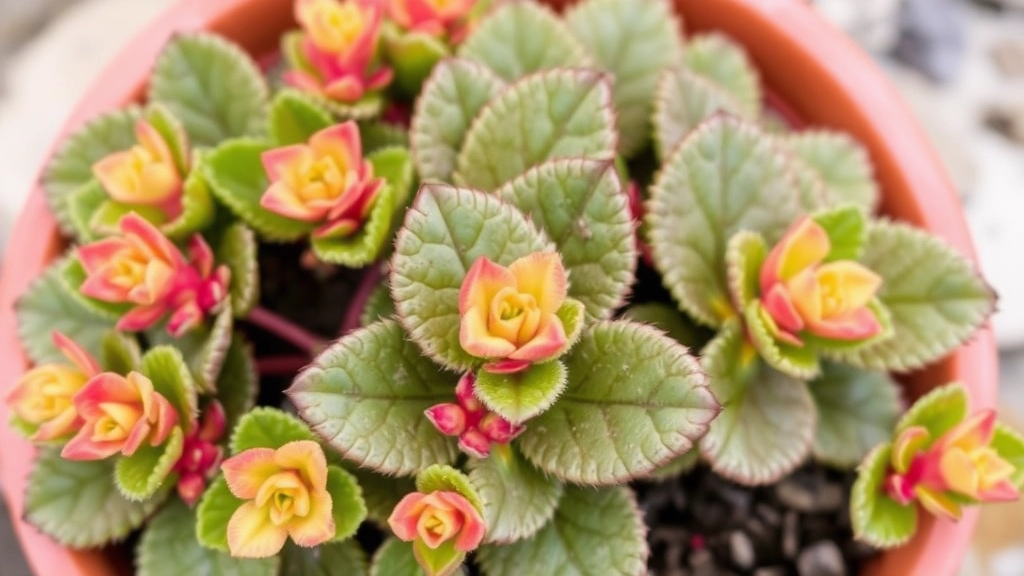
As we delve deeper into the temperature challenges faced by Kalanchoe, it’s vital to understand how low temperatures specifically impact this resilient succulent.
Kalanchoe thrives in warm climates, and exposure to low temperatures can lead to several adverse effects.
Key Effects of Low Temperatures:
- Leaf Damage: When temperatures drop below 10°C (50°F), Kalanchoe leaves can begin to wilt and turn mushy. This is a sign of cellular damage due to frost.
- Stunted Growth: Cold conditions can slow down the plant’s growth significantly. You may notice that your Kalanchoe is not producing new leaves or flowers as it usually would.
- Root Rot: If the soil remains cold and damp, it increases the risk of root rot. This can occur when the plant is kept in overly moist conditions during colder months.
- Flower Drop: Low temperatures can cause flowers to drop prematurely, affecting the overall aesthetic of your plant.
To help illustrate, consider a friend who kept their Kalanchoe outdoors during an unexpected cold snap. They found their once-vibrant plant drooping and struggling to recover, highlighting the importance of temperature awareness.
Preventive Measures:
- Bring Indoors: If you expect a cold spell, bring your Kalanchoe indoors to a warmer location.
- Use Cloches or Covers: For outdoor plants, consider using cloches or frost covers to provide extra warmth.
- Monitor Soil Moisture: Ensure the soil is well-draining and not overly wet during colder weather.
Indoor vs. Outdoor Temperature Conditions
When considering the best temperature conditions for Kalanchoe, many plant enthusiasts often wonder whether their indoor or outdoor environment is more suitable for this resilient succulent.
Indoor Temperature Conditions
Indoor environments typically provide a stable climate for Kalanchoe.
- Ideal Range: The optimal temperature range for indoor Kalanchoe is between 18°C and 24°C (65°F to 75°F).
- Humidity Control: Indoor settings often have controlled humidity levels, which can be beneficial for the plant’s overall health.
- Artificial Lighting: Using grow lights can help maintain the necessary light and warmth, especially during winter months.
However, indoor plants can also suffer from temperature extremes due to heating systems or air conditioning.
- Avoid Drafts: Keep Kalanchoe away from cold drafts or heat sources, which can cause stress.
Outdoor Temperature Conditions
Outdoor conditions can be more variable, and while Kalanchoe can thrive outside, it requires careful monitoring.
- Ideal Range: During the growing season, Kalanchoe can tolerate temperatures between 20°C and 28°C (68°F to 82°F).
- Natural Light: Outdoor plants benefit from natural sunlight, which can enhance their growth and flowering.
- Soil Temperature: The soil temperature should also be considered, as it can affect root health.
However, outdoor Kalanchoe faces challenges such as:
- Extreme Heat: Prolonged exposure to high temperatures can lead to wilting or sunburn.
- Cold Nights: Sudden drops in temperature at night can stress the plant.
In summary, while indoor conditions offer stability, outdoor environments provide natural benefits but require careful management. For more detailed care instructions, you can refer to this complete guide to Kalanchoe plant care. Additionally, if you are interested in specific varieties, check out these top Kalanchoe succulent varieties and care tips.
Seasonal Temperature Adjustments
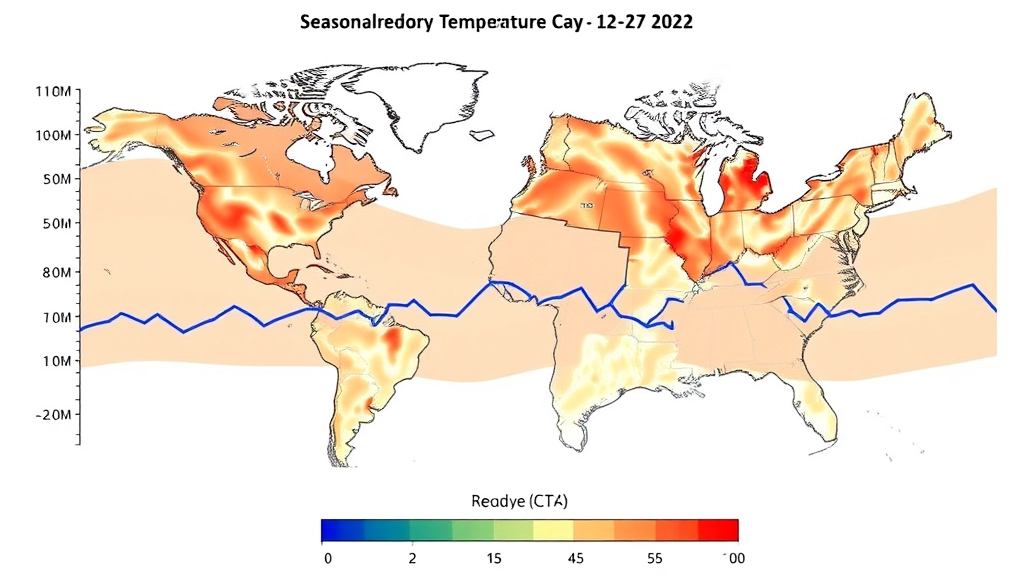
As the seasons change, so do the temperature needs of your Kalanchoe.
You might be wondering, “How do I keep my plant thriving through summer heat or winter chills?”
Spring and Summer:
- Warmth is Key: Kalanchoe loves warmth, ideally between 20-25°C (68-77°F).
- Keep it Breezy: Ensure good airflow to prevent overheating.
- Water Wisely: With the heat, you might need to water more often, but be careful not to overdo it.
Autumn:
- Gradual Transition: As temperatures start to drop, ease up on watering.
- Monitor Light: Days get shorter, so consider moving your Kalanchoe to a sunnier spot to keep it happy.
Winter:
- Chilly Conditions: Aim for a temperature around 15°C (59°F) or higher.
- Avoid Cold Drafts: Keep your plant away from windows or doors that may let in cold air.
- Less Water: Your Kalanchoe will be in a dormant phase, so cut back on watering to avoid root rot.
Protecting Kalanchoe from Frost
As we delve deeper into caring for Kalanchoe, the concern of frost protection becomes paramount, especially in colder months.
Why Frost Matters for Kalanchoe
Kalanchoe is a tropical plant that thrives in warm environments. When temperatures drop, especially below 5°C (41°F), frost can cause significant damage. Here’s how to safeguard your beloved plant:
- Bring Indoors:
- If temperatures are forecasted to drop, bring your Kalanchoe indoors.
- Place it in a bright, warm spot away from drafts.
- Use Frost Cloths:
- Cover outdoor plants with frost cloths or blankets during cold nights.
- Ensure the covering is loose to allow air circulation.
- Mulch Application:
- Apply a layer of mulch around the base of outdoor Kalanchoe.
- This insulates the roots and retains soil warmth.
- Choose the Right Location:
- Position your Kalanchoe in a sheltered area, such as near a wall or under a tree.
- This can provide extra protection from harsh winds and frost.
- Monitor Weather Conditions:
- Keep an eye on local weather forecasts.
- Be proactive in taking steps when frost warnings are issued.
- Use Heating Mats:
- For indoor plants, consider using heating mats to maintain optimal soil temperature.
- This can be particularly useful during unexpected cold snaps.
Taking these precautions can make a significant difference in the health of your Kalanchoe during frosty conditions. For more detailed care tips, check out our Complete Care Guide for Kalanchoe Blossfeldiana or learn how to harvest Kalanchoe seeds for future planting.
Signs of Temperature Stress in Kalanchoe
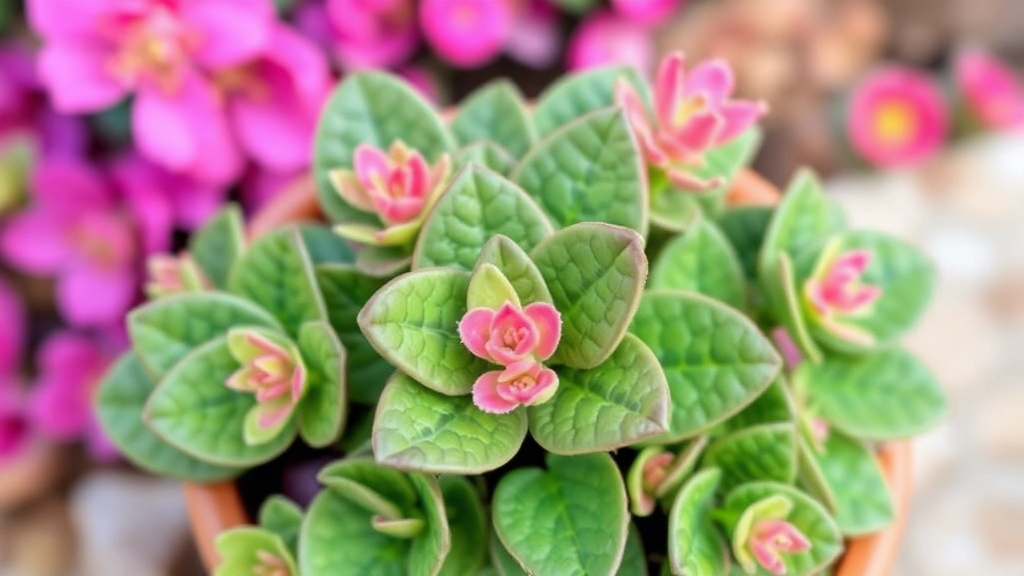
So, you’ve been keeping an eye on your Kalanchoe, but how do you know if it’s feeling the heat—or the chill?
Temperature stress can sneak up on you, and your plant might not look too happy about it. Here are some signs to watch out for:
- Wilting Leaves: If your Kalanchoe’s leaves are drooping, it could be a sign of heat stress. They might look lifeless and saggy.
- Leaf Discoloration: Yellowing leaves can indicate either too much heat or too cold. If the edges turn brown, it’s a cry for help.
- Soft, Mushy Stems: This is often a result of too much moisture combined with high temperatures. Your plant might be trying to tell you it’s struggling.
- Leaf Drop: If you notice leaves falling off, it could be due to temperature fluctuations. Kalanchoes like consistency!
- Stunted Growth: If your plant seems to be on a growth break, it might be feeling too hot or too cold. Kalanchoes thrive in their ideal temperature range, and anything outside that can slow them down.
- Flowering Issues: If your Kalanchoe isn’t blooming as it should, temperature stress could be the culprit.
These signs can help you pinpoint what’s going on with your Kalanchoe. If you catch these symptoms early, you’ll have a better chance of getting your plant back on track.
Tips for Maintaining Optimal Temperature
Maintaining the ideal temperature for your Kalanchoe is essential for its health and growth. You may be wondering how to create the perfect environment for your plant. Here are some straightforward tips to help you achieve that.
1. Location Matters
- Choose the Right Spot: Place your Kalanchoe near a window where it can receive plenty of indirect sunlight.
- Avoid Drafts: Keep it away from drafty windows or doors that may expose it to sudden temperature changes.
2. Monitor Temperature
- Use a Thermometer: Regularly check the temperature in the room. Ideal temperatures range from 20°C to 24°C (68°F to 75°F).
- Nighttime Considerations: At night, temperatures can drop slightly, but aim to keep them above 10°C (50°F).
3. Seasonal Adjustments
- Adapt for Seasons: During winter, consider moving your plant closer to a heat source, but avoid direct contact with radiators.
- Cool Down in Summer: If temperatures soar above 30°C (86°F), provide some shade or move the plant to a cooler area.
4. Humidity Control
- Maintain Low Humidity: Kalanchoe thrives in low humidity. If your home is too humid, consider using a dehumidifier.
- Air Circulation: Ensure good air circulation around the plant to prevent overheating.
5. Protective Measures
- Frost Protection: In colder months, use fabric covers or move your Kalanchoe indoors if frost is expected.
- Heat Stress Prevention: If you notice signs of heat stress, such as wilting leaves, relocate the plant to a cooler spot immediately.
For more detailed care instructions, you might find the Comprehensive Kalanchoe Plant Care Guide helpful. Additionally, if you’re interested in propagating your plant, check out this guide on propagating Kalanchoe from leaves.
FAQs about Kalanchoe Temperature Range
What is the ideal temperature range for Kalanchoe plants?
Kalanchoe plants thrive in temperatures between 15°C to 25°C (59°F to 77°F). This range provides the optimal conditions for growth and flowering.
Can Kalanchoe tolerate temperatures outside the ideal range?
Yes, Kalanchoe can tolerate temperatures slightly outside the ideal range. They can handle minimum temperatures down to about 5°C (41°F) and maximum temperatures up to around 30°C (86°F). However, it’s best not to expose them to these extremes for prolonged periods.
What happens to Kalanchoe at low temperatures?
Exposure to low temperatures can lead to several adverse effects on Kalanchoe, such as:
- Leaf Damage: Leaves can wilt and turn mushy below 10°C (50°F).
- Stunted Growth: Cold conditions slow down growth.
- Root Rot: Increased risk if soil remains cold and damp.
- Flower Drop: Flowers may drop prematurely.
How can I protect my Kalanchoe from cold temperatures?
To protect your Kalanchoe from cold temperatures, consider these preventive measures:
- Bring Indoors: Move the plant to a warmer location during cold spells.
- Use Cloches or Covers: Provide extra warmth for outdoor plants.
- Monitor Soil Moisture: Ensure well-draining soil and avoid overwatering.
How should I adjust care for Kalanchoe with seasonal temperature changes?
Seasonal changes require different care approaches:
Spring and Summer:
- Warmth is Key: Maintain temperatures between 20-25°C (68-77°F).
- Keep it Breezy: Ensure good airflow.
- Water Wisely: Increase watering but avoid overwatering.
Autumn:
- Gradual Transition: Reduce watering as temperatures drop.
- Monitor Light: Move to sunnier spots as days shorten.
Winter:
- Chilly Conditions: Maintain temperatures around 15°C (59°F) or higher.
- Avoid Cold Drafts: Keep away from windows or doors.
- Less Water: Reduce watering during dormancy.
What are the signs of temperature stress in Kalanchoe?
Signs of temperature stress in Kalanchoe include:
- Wilting Leaves: Drooping leaves indicate heat stress.
- Leaf Discoloration: Yellowing or browning edges signal temperature issues.
- Soft, Mushy Stems: Often due to too much moisture and high temperatures.
- Leaf Drop: Leaves falling off due to temperature fluctuations.
- Stunted Growth: Lack of growth due to unsuitable temperatures.
- Flowering Issues: Poor blooming linked to temperature stress.
By recognizing these signs early, you can take steps to adjust the environment and help your Kalanchoe recover.
References
-
Gardening Know How: Kalanchoe Plant Care
-
The Spruce: Growing Kalanchoe Succulents
-
The Old Farmer’s Almanac: How to Grow Kalanchoe
